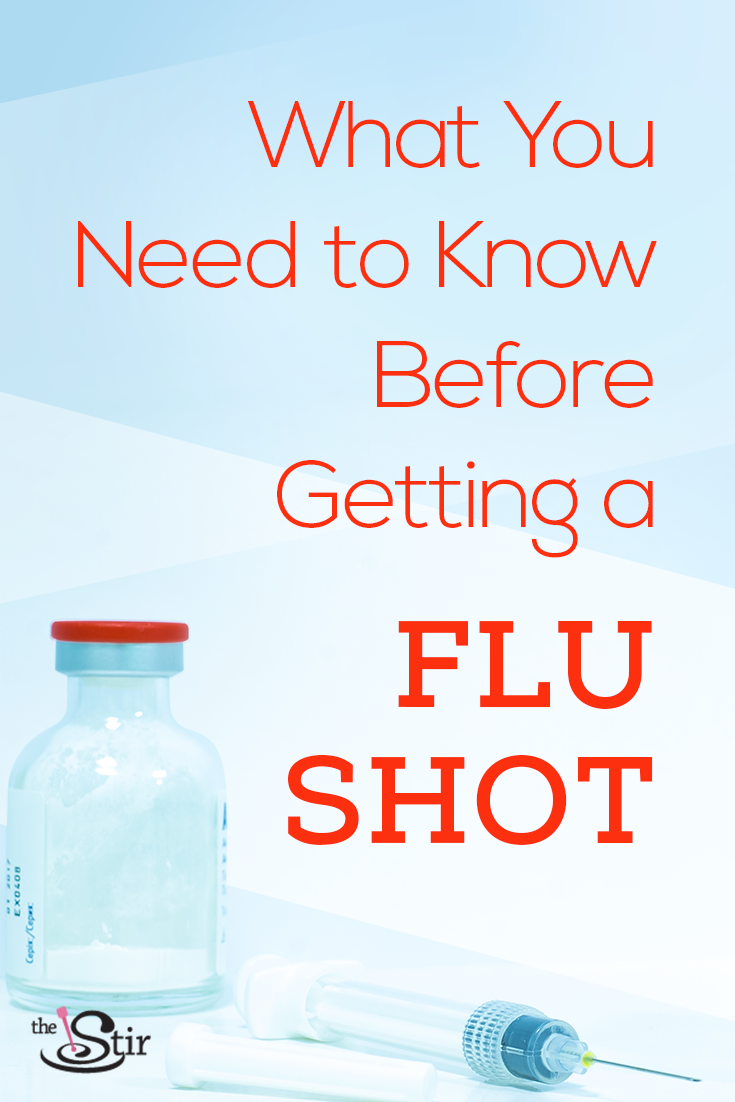Most people recover within a week or two from the stuffy nose, high fever, sore throat, and fatigue that come with the flu. But not everybody. In the past three decades, anywhere from 3,000 to 49,000 people have died from the flu per YEAR.
The best way to stay safe and healthy? (Besides washing your hands or wearing a mask over your nose?) You guessed it: getting a flu shot. Here’s what you need to know:
- You can spread the flu even if you don’t feel sick. Being infected won’t always cause symptoms like sneezing, coughing, and running a fever. But it CAN make you feel guilty.
- A flu shot does kinda give you the flu. Sort of–ish. Like other vaccines, the flu shot contains a teeny-tiny amount of killed or weakened flu strains that researchers think will be common this season. That causes your body to make antibodies that will fight off the germs next time you’re exposed. It doesn’t happen instantly, though. Protection only kicks in two weeks AFTER your shot. More from The Stir: The New Flu Vaccine Will Reportedly Beat Last Year’s Shot: All the Details
- Older people are hit harder by the flu. During recent flu seasons, as many as 90 percent of related deaths were of people 65 and older. Other people at high risk of complications? Pregnant women, very young kiddos, and anyone with a long-term medical condition like asthma, diabetes, or heart disease.
- You can feel flu-ish after getting a flu shot. You may experience flu-like symptoms after the shot — like achiness, or tenderness and redness at the site of the injection. Some people who get the nasal spray version have a sore throat or stuffy nose.
- When given with other shots, the flu shot can cause febrile seizures. A Centers for Disease Control (CDC) study showed that when kids are vaccinated for the flu at the same time they get DTap or PCV13 shots, they risk having a febrile seizure (a seizure usually accompanied by a high fever) over the next 24 hours. It’s a small enough risk that the CDC doesn’t recommend waiting to vaccinate on different days, but it can’t hurt to talk to your pediatrician.
- You need to take extra precautions if you have an egg allergy. That’s because antibodies in the standard flu shot are made using a virus grown in eggs. We know. It’s icky. (See #7.) Talk to your primary care person about getting an egg-free flu shot.
- Making a flu vaccine ain’t easy OR pretty. Your flu shot actually began its journey back in February. Scientists collected popular strains of flu viruses from around the world, injected them into millions of fertilized eggs, and allowed them to incubate and grow. The infected fluid’s since been harvested, purified, and tested for safety before coming to a syringe near you! More from The Stir: 10 Flu Shot Pros & Cons to Help You Decide If It’s for You (PHOTOS)
- This year’s flu shot should be better than last year’s. A series of small genetic changes can make a flu strain just different enough that your body doesn’t recognize it from the vaccine. Which is a bummer. That’s what happened last year, but the Centers for Disease Control and Prevention feel the 2015 formulation can now match mutational changes of three of the most common flu strains.
- You’re still not protected against flu-like viruses. Only 20 percent of flu-like illness are actually caused by two main influenza strains included in the flu vaccine. What does that mean? Well, there are still more than 200 bugs floating around that can make you sick — and which the flu shot is helpless to prevent.
- One shot may work better than two. Weirdly, some research shows that getting a flu shot two years in a row actually decreases vaccine effectiveness. Still, many experts think annual shots for the long term are still the way to go. (What you do is up to you.) Image © FGorgun/iStock



title: “10 Flu Shot Facts You Should Know Before Getting The Vaccine” ShowToc: true date: “2024-10-02” author: “Richard Hoggatt”
Most people recover within a week or two from the stuffy nose, high fever, sore throat, and fatigue that come with the flu. But not everybody. In the past three decades, anywhere from 3,000 to 49,000 people have died from the flu per YEAR.
The best way to stay safe and healthy? (Besides washing your hands or wearing a mask over your nose?) You guessed it: getting a flu shot. Here’s what you need to know:
- You can spread the flu even if you don’t feel sick. Being infected won’t always cause symptoms like sneezing, coughing, and running a fever. But it CAN make you feel guilty.
- A flu shot does kinda give you the flu. Sort of–ish. Like other vaccines, the flu shot contains a teeny-tiny amount of killed or weakened flu strains that researchers think will be common this season. That causes your body to make antibodies that will fight off the germs next time you’re exposed. It doesn’t happen instantly, though. Protection only kicks in two weeks AFTER your shot. More from The Stir: The New Flu Vaccine Will Reportedly Beat Last Year’s Shot: All the Details
- Older people are hit harder by the flu. During recent flu seasons, as many as 90 percent of related deaths were of people 65 and older. Other people at high risk of complications? Pregnant women, very young kiddos, and anyone with a long-term medical condition like asthma, diabetes, or heart disease.
- You can feel flu-ish after getting a flu shot. You may experience flu-like symptoms after the shot — like achiness, or tenderness and redness at the site of the injection. Some people who get the nasal spray version have a sore throat or stuffy nose.
- When given with other shots, the flu shot can cause febrile seizures. A Centers for Disease Control (CDC) study showed that when kids are vaccinated for the flu at the same time they get DTap or PCV13 shots, they risk having a febrile seizure (a seizure usually accompanied by a high fever) over the next 24 hours. It’s a small enough risk that the CDC doesn’t recommend waiting to vaccinate on different days, but it can’t hurt to talk to your pediatrician.
- You need to take extra precautions if you have an egg allergy. That’s because antibodies in the standard flu shot are made using a virus grown in eggs. We know. It’s icky. (See #7.) Talk to your primary care person about getting an egg-free flu shot.
- Making a flu vaccine ain’t easy OR pretty. Your flu shot actually began its journey back in February. Scientists collected popular strains of flu viruses from around the world, injected them into millions of fertilized eggs, and allowed them to incubate and grow. The infected fluid’s since been harvested, purified, and tested for safety before coming to a syringe near you! More from The Stir: 10 Flu Shot Pros & Cons to Help You Decide If It’s for You (PHOTOS)
- This year’s flu shot should be better than last year’s. A series of small genetic changes can make a flu strain just different enough that your body doesn’t recognize it from the vaccine. Which is a bummer. That’s what happened last year, but the Centers for Disease Control and Prevention feel the 2015 formulation can now match mutational changes of three of the most common flu strains.
- You’re still not protected against flu-like viruses. Only 20 percent of flu-like illness are actually caused by two main influenza strains included in the flu vaccine. What does that mean? Well, there are still more than 200 bugs floating around that can make you sick — and which the flu shot is helpless to prevent.
- One shot may work better than two. Weirdly, some research shows that getting a flu shot two years in a row actually decreases vaccine effectiveness. Still, many experts think annual shots for the long term are still the way to go. (What you do is up to you.) Image © FGorgun/iStock



title: “10 Flu Shot Facts You Should Know Before Getting The Vaccine” ShowToc: true date: “2024-10-08” author: “Donald Gouty”
Most people recover within a week or two from the stuffy nose, high fever, sore throat, and fatigue that come with the flu. But not everybody. In the past three decades, anywhere from 3,000 to 49,000 people have died from the flu per YEAR.
The best way to stay safe and healthy? (Besides washing your hands or wearing a mask over your nose?) You guessed it: getting a flu shot. Here’s what you need to know:
- You can spread the flu even if you don’t feel sick. Being infected won’t always cause symptoms like sneezing, coughing, and running a fever. But it CAN make you feel guilty.
- A flu shot does kinda give you the flu. Sort of–ish. Like other vaccines, the flu shot contains a teeny-tiny amount of killed or weakened flu strains that researchers think will be common this season. That causes your body to make antibodies that will fight off the germs next time you’re exposed. It doesn’t happen instantly, though. Protection only kicks in two weeks AFTER your shot. More from The Stir: The New Flu Vaccine Will Reportedly Beat Last Year’s Shot: All the Details
- Older people are hit harder by the flu. During recent flu seasons, as many as 90 percent of related deaths were of people 65 and older. Other people at high risk of complications? Pregnant women, very young kiddos, and anyone with a long-term medical condition like asthma, diabetes, or heart disease.
- You can feel flu-ish after getting a flu shot. You may experience flu-like symptoms after the shot — like achiness, or tenderness and redness at the site of the injection. Some people who get the nasal spray version have a sore throat or stuffy nose.
- When given with other shots, the flu shot can cause febrile seizures. A Centers for Disease Control (CDC) study showed that when kids are vaccinated for the flu at the same time they get DTap or PCV13 shots, they risk having a febrile seizure (a seizure usually accompanied by a high fever) over the next 24 hours. It’s a small enough risk that the CDC doesn’t recommend waiting to vaccinate on different days, but it can’t hurt to talk to your pediatrician.
- You need to take extra precautions if you have an egg allergy. That’s because antibodies in the standard flu shot are made using a virus grown in eggs. We know. It’s icky. (See #7.) Talk to your primary care person about getting an egg-free flu shot.
- Making a flu vaccine ain’t easy OR pretty. Your flu shot actually began its journey back in February. Scientists collected popular strains of flu viruses from around the world, injected them into millions of fertilized eggs, and allowed them to incubate and grow. The infected fluid’s since been harvested, purified, and tested for safety before coming to a syringe near you! More from The Stir: 10 Flu Shot Pros & Cons to Help You Decide If It’s for You (PHOTOS)
- This year’s flu shot should be better than last year’s. A series of small genetic changes can make a flu strain just different enough that your body doesn’t recognize it from the vaccine. Which is a bummer. That’s what happened last year, but the Centers for Disease Control and Prevention feel the 2015 formulation can now match mutational changes of three of the most common flu strains.
- You’re still not protected against flu-like viruses. Only 20 percent of flu-like illness are actually caused by two main influenza strains included in the flu vaccine. What does that mean? Well, there are still more than 200 bugs floating around that can make you sick — and which the flu shot is helpless to prevent.
- One shot may work better than two. Weirdly, some research shows that getting a flu shot two years in a row actually decreases vaccine effectiveness. Still, many experts think annual shots for the long term are still the way to go. (What you do is up to you.) Image © FGorgun/iStock



title: “10 Flu Shot Facts You Should Know Before Getting The Vaccine” ShowToc: true date: “2024-09-19” author: “Brian Moore”
Most people recover within a week or two from the stuffy nose, high fever, sore throat, and fatigue that come with the flu. But not everybody. In the past three decades, anywhere from 3,000 to 49,000 people have died from the flu per YEAR.
The best way to stay safe and healthy? (Besides washing your hands or wearing a mask over your nose?) You guessed it: getting a flu shot. Here’s what you need to know:
- You can spread the flu even if you don’t feel sick. Being infected won’t always cause symptoms like sneezing, coughing, and running a fever. But it CAN make you feel guilty.
- A flu shot does kinda give you the flu. Sort of–ish. Like other vaccines, the flu shot contains a teeny-tiny amount of killed or weakened flu strains that researchers think will be common this season. That causes your body to make antibodies that will fight off the germs next time you’re exposed. It doesn’t happen instantly, though. Protection only kicks in two weeks AFTER your shot. More from The Stir: The New Flu Vaccine Will Reportedly Beat Last Year’s Shot: All the Details
- Older people are hit harder by the flu. During recent flu seasons, as many as 90 percent of related deaths were of people 65 and older. Other people at high risk of complications? Pregnant women, very young kiddos, and anyone with a long-term medical condition like asthma, diabetes, or heart disease.
- You can feel flu-ish after getting a flu shot. You may experience flu-like symptoms after the shot — like achiness, or tenderness and redness at the site of the injection. Some people who get the nasal spray version have a sore throat or stuffy nose.
- When given with other shots, the flu shot can cause febrile seizures. A Centers for Disease Control (CDC) study showed that when kids are vaccinated for the flu at the same time they get DTap or PCV13 shots, they risk having a febrile seizure (a seizure usually accompanied by a high fever) over the next 24 hours. It’s a small enough risk that the CDC doesn’t recommend waiting to vaccinate on different days, but it can’t hurt to talk to your pediatrician.
- You need to take extra precautions if you have an egg allergy. That’s because antibodies in the standard flu shot are made using a virus grown in eggs. We know. It’s icky. (See #7.) Talk to your primary care person about getting an egg-free flu shot.
- Making a flu vaccine ain’t easy OR pretty. Your flu shot actually began its journey back in February. Scientists collected popular strains of flu viruses from around the world, injected them into millions of fertilized eggs, and allowed them to incubate and grow. The infected fluid’s since been harvested, purified, and tested for safety before coming to a syringe near you! More from The Stir: 10 Flu Shot Pros & Cons to Help You Decide If It’s for You (PHOTOS)
- This year’s flu shot should be better than last year’s. A series of small genetic changes can make a flu strain just different enough that your body doesn’t recognize it from the vaccine. Which is a bummer. That’s what happened last year, but the Centers for Disease Control and Prevention feel the 2015 formulation can now match mutational changes of three of the most common flu strains.
- You’re still not protected against flu-like viruses. Only 20 percent of flu-like illness are actually caused by two main influenza strains included in the flu vaccine. What does that mean? Well, there are still more than 200 bugs floating around that can make you sick — and which the flu shot is helpless to prevent.
- One shot may work better than two. Weirdly, some research shows that getting a flu shot two years in a row actually decreases vaccine effectiveness. Still, many experts think annual shots for the long term are still the way to go. (What you do is up to you.) Image © FGorgun/iStock


